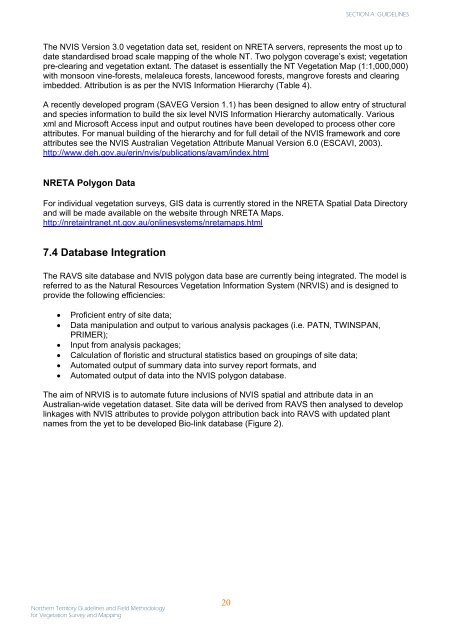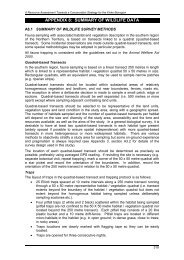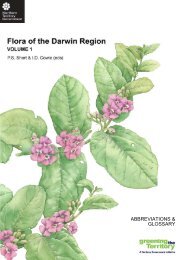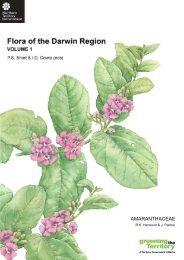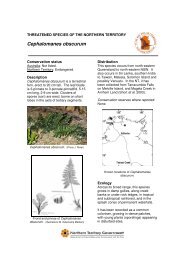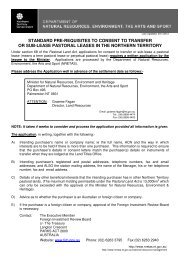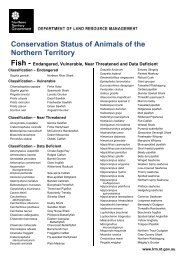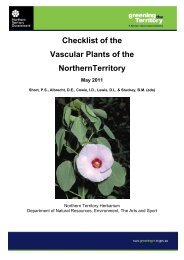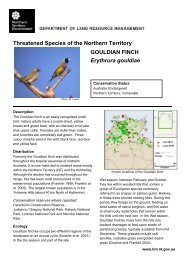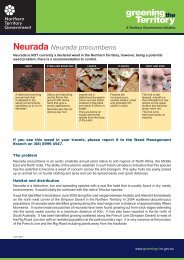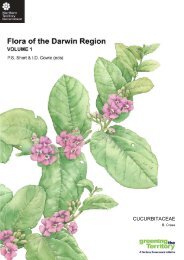Guidelines and Field Methodology for Vegetation Survey and Mapping
Guidelines and Field Methodology for Vegetation Survey and Mapping
Guidelines and Field Methodology for Vegetation Survey and Mapping
Create successful ePaper yourself
Turn your PDF publications into a flip-book with our unique Google optimized e-Paper software.
SECTION A: GUIDELINES<br />
The NVIS Version 3.0 vegetation data set, resident on NRETA servers, represents the most up to<br />
date st<strong>and</strong>ardised broad scale mapping of the whole NT. Two polygon coverage’s exist; vegetation<br />
pre-clearing <strong>and</strong> vegetation extant. The dataset is essentially the NT <strong>Vegetation</strong> Map (1:1,000,000)<br />
with monsoon vine-<strong>for</strong>ests, melaleuca <strong>for</strong>ests, lancewood <strong>for</strong>ests, mangrove <strong>for</strong>ests <strong>and</strong> clearing<br />
imbedded. Attribution is as per the NVIS In<strong>for</strong>mation Hierarchy (Table 4).<br />
A recently developed program (SAVEG Version 1.1) has been designed to allow entry of structural<br />
<strong>and</strong> species in<strong>for</strong>mation to build the six level NVIS In<strong>for</strong>mation Hierarchy automatically. Various<br />
xml <strong>and</strong> Microsoft Access input <strong>and</strong> output routines have been developed to process other core<br />
attributes. For manual building of the hierarchy <strong>and</strong> <strong>for</strong> full detail of the NVIS framework <strong>and</strong> core<br />
attributes see the NVIS Australian <strong>Vegetation</strong> Attribute Manual Version 6.0 (ESCAVI, 2003).<br />
http://www.deh.gov.au/erin/nvis/publications/avam/index.html<br />
NRETA Polygon Data<br />
For individual vegetation surveys, GIS data is currently stored in the NRETA Spatial Data Directory<br />
<strong>and</strong> will be made available on the website through NRETA Maps.<br />
http://nretaintranet.nt.gov.au/onlinesystems/nretamaps.html<br />
7.4 Database Integration<br />
The RAVS site database <strong>and</strong> NVIS polygon data base are currently being integrated. The model is<br />
referred to as the Natural Resources <strong>Vegetation</strong> In<strong>for</strong>mation System (NRVIS) <strong>and</strong> is designed to<br />
provide the following efficiencies:<br />
• Proficient entry of site data;<br />
• Data manipulation <strong>and</strong> output to various analysis packages (i.e. PATN, TWINSPAN,<br />
PRIMER);<br />
• Input from analysis packages;<br />
• Calculation of floristic <strong>and</strong> structural statistics based on groupings of site data;<br />
• Automated output of summary data into survey report <strong>for</strong>mats, <strong>and</strong><br />
• Automated output of data into the NVIS polygon database.<br />
The aim of NRVIS is to automate future inclusions of NVIS spatial <strong>and</strong> attribute data in an<br />
Australian-wide vegetation dataset. Site data will be derived from RAVS then analysed to develop<br />
linkages with NVIS attributes to provide polygon attribution back into RAVS with updated plant<br />
names from the yet to be developed Bio-link database (Figure 2).<br />
Northern Territory <strong>Guidelines</strong> <strong>and</strong> <strong>Field</strong> <strong>Methodology</strong><br />
<strong>for</strong> <strong>Vegetation</strong> <strong>Survey</strong> <strong>and</strong> <strong>Mapping</strong><br />
20


